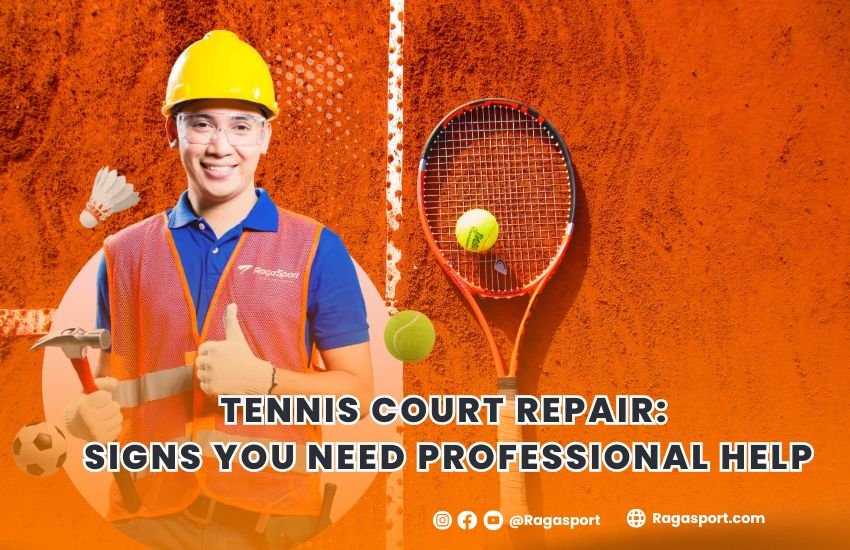Tennis Court Repair: Signs You Need Professional Help
A tennis court isn’t just concrete and paint it’s a space where strategy meets sweat, where champions are born, and where friendships are forged across the net. But like any great arena, your court needs care. Time, weather, and wear can turn your once-pristine playing surface into a patchwork of cracks, puddles, and faded lines.
Is your tennis court showing signs of damage? Learn when to call in professional tennis court repair services before cracks and drainage issues ruin your game.
Table of Contents
1. Cracks That Keep Coming Back
Hairline cracks might seem harmless at first. But over time, especially with heat and moisture creeping in, they widen, deepen, and multiply like bad habits.
The Red Flags:
- You fill them, they return.
- Some cracks are wider than a coin.
- The surface feels uneven near the damaged area.
These cracks could be symptoms of deeper structural issues. A professional can not only patch them up but address what’s happening below the surface—something no DIY kit can promise.
2. Water That Refuses to Leave
If your court turns into a shallow swimming pool every time it rains, you’ve got a drainage problem. Standing water is a silent court killer—it seeps into cracks, weakens the foundation, and attracts mold.
Common Causes:
- Improper slope or leveling.
- Blocked or damaged drainage systems.
- Worn-out surface coatings that no longer repel water.
A proper contractor will assess the court’s drainage design, regrade if necessary, and resurface with water-resistant materials. No more puddles, no more delays.
3. Your Lines Are Fading into the Sunset
Lines are more than just markers—they define the game. When they start fading or peeling off, it’s more than a cosmetic issue; it affects playability and fairness.
And here’s the kicker: if the lines are fading, chances are the entire surface is aging, losing grip, and becoming unsafe.
Look Out For:
- Barely visible service lines.
- Discoloration in large patches.
- Surface so smooth it feels like ice in certain spots.
Professionals will not only repaint your lines but restore the entire surface to standard, improving traction, aesthetics, and game quality.
4. The Bounce Feels… Off
You hit the perfect serve—and it bounces weirdly sideways. That’s not just your opponent’s spin; it could be your court telling you something’s wrong.
Uneven surfaces mess with your game. They affect bounce consistency, footwork, and even increase injury risk.
Causes:
- Shifting soil beneath the court.
- Water damage or erosion.
- Poor original construction.
Fixing this isn’t about patching dips. It could mean resurfacing or even rebuilding a portion of the base. A job for trained hands—not a weekend warrior.
5. Nets and Fences Falling Apart

It’s easy to focus only on the court surface, but if your fencing is sagging or the net leans like a tired old man, it’s time for a full check-up.
These issues can quickly become safety hazards, especially in competitive or public play environments.
Warning Signs:
- Rusty or broken fence posts.
- Torn, drooping nets.
- Loose posts and anchors.
Professionals will ensure everything around your court is as durable and sharp-looking as the surface itself.
6. Players Are Complaining (And Not Just About Losing)
Your players are your best sensors. If they start commenting on slippery spots, awkward bounces, or “dead zones” where the ball doesn’t behave—it’s a signal. Don’t brush off feedback, especially from experienced players.
A tennis court should enhance performance, not hinder it.
7. It’s Been a While… Like, Really a While
When was the last time your court had professional resurfacing?
If you’re scratching your head, it’s probably been too long.
Most hard courts need a refresh every 4–8 years. Even if it still looks “okay,” small invisible issues could be festering. An expert evaluation could save you from a costly full reconstruction down the road.
Why You Shouldn’t Go It Alone
Sure, there are court repair kits, YouTube tutorials, and even DIY resurfacing guides out there. But the truth is: tennis court repair is a science—and an art.
Why professionals are worth it:
- Diagnosis before damage: They see what’s wrong beneath the surface.
- Proper tools and materials: No cutting corners.
- Longer-lasting results: Done once, done right.
- Safety and standards: Essential for schools, clubs, and serious play.
Trust Your Court with Experts Who Know the Game
Not all contractors are built the same. Look for specialists in sports flooring and court construction. You want someone who knows how to balance performance, safety, and aesthetics—all while using top-grade materials that last.
Whether your court needs a minor facelift or a total overhaul, don’t wait until it’s unusable.
Game, Set, Match Let’s Fix Your Court Right

If your tennis court is showing any of the signs above, don’t let the damage serve you a loss. It’s time to restore it to its prime and Raga Sport is ready to help.
🎾 From repairs to full resurfacing, we deliver premium results that last.
🔧 Our team specializes in sports construction with a proven track record across Indonesia.
👉 Visit Raga Sport for more info
📲 Contact us now on WhatsApp for a free consultation

